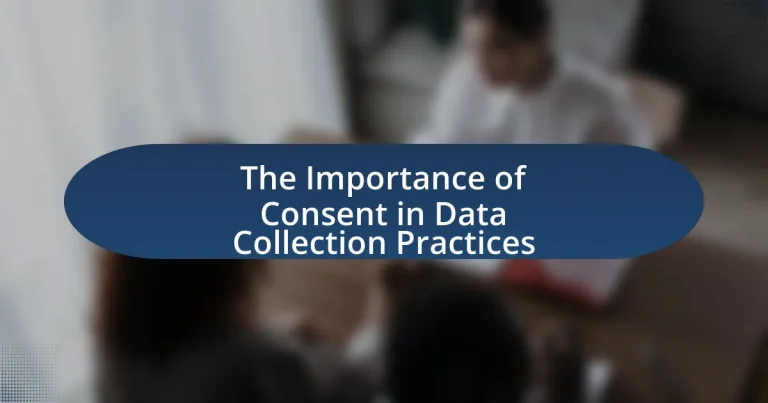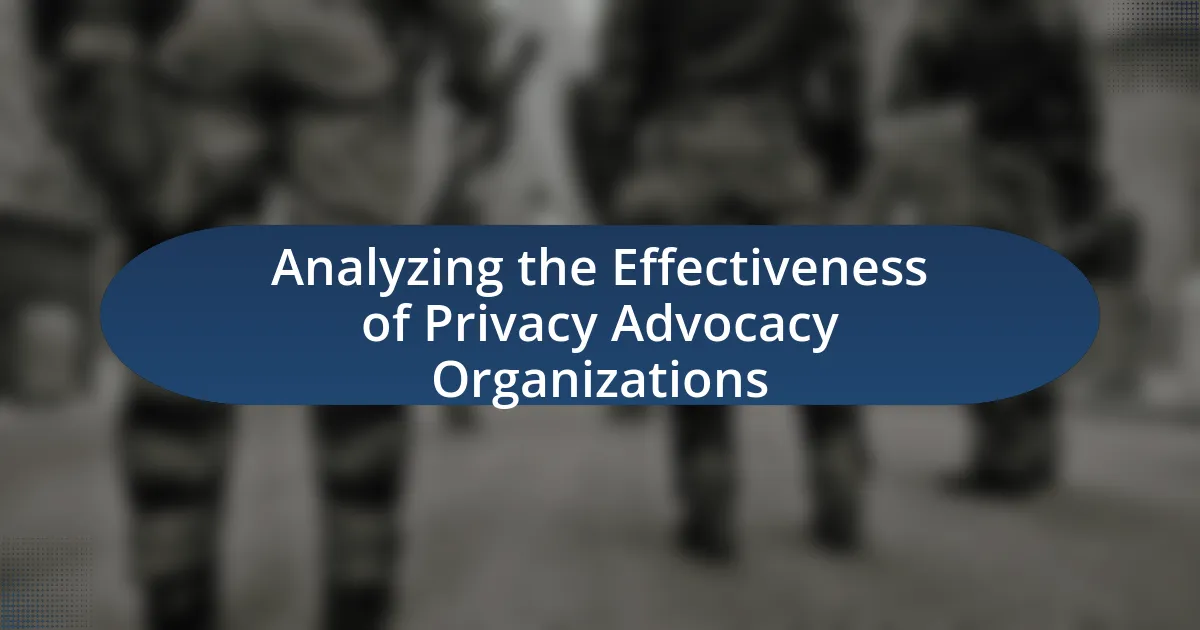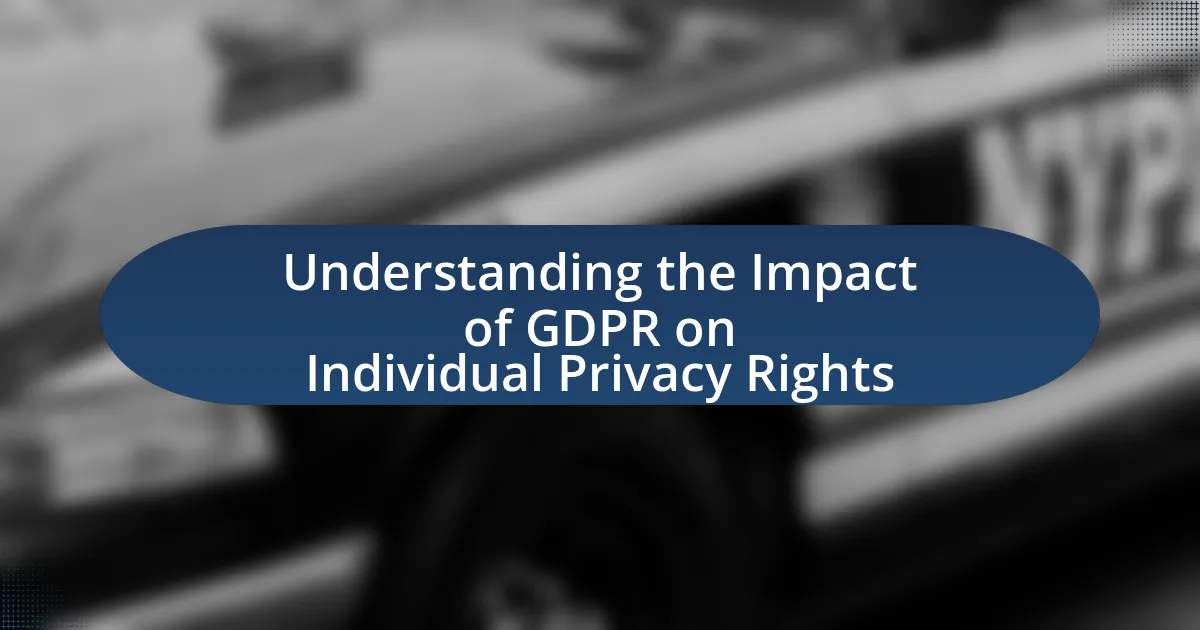The main entity of the article is the concept of consent in data collection practices. The article emphasizes the critical role of consent in ensuring individuals have control over their personal information, fostering trust between data collectors and users, and adhering to legal frameworks such as the General Data Protection Regulation (GDPR) and the California Consumer Privacy Act (CCPA). It discusses the ethical implications of obtaining consent, the impact on user trust and engagement, and the various types of consent, including explicit and implicit consent. Additionally, the article outlines best practices for organizations to enhance transparency and maintain consent integrity, while addressing the challenges and consequences of neglecting consent in data collection.
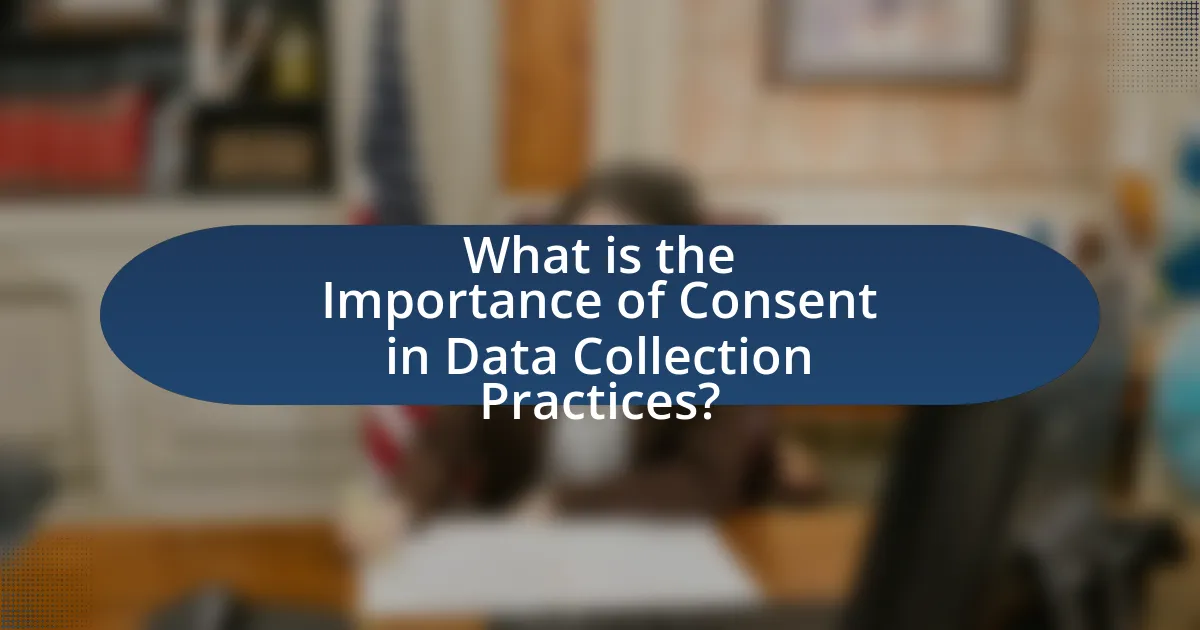
What is the Importance of Consent in Data Collection Practices?
Consent is crucial in data collection practices as it ensures that individuals have control over their personal information. This control fosters trust between data collectors and individuals, promoting ethical standards in data handling. According to the General Data Protection Regulation (GDPR), consent must be informed, specific, and freely given, which reinforces the legal obligation for organizations to respect individuals’ privacy rights. Furthermore, studies indicate that transparent consent processes can enhance user engagement and satisfaction, as individuals are more likely to share data when they understand how it will be used.
Why is consent crucial in data collection?
Consent is crucial in data collection because it ensures that individuals have control over their personal information and understand how it will be used. This control fosters trust between data collectors and participants, which is essential for ethical practices. According to the General Data Protection Regulation (GDPR), obtaining explicit consent is a legal requirement for processing personal data, emphasizing the importance of transparency and individual rights in data handling. Furthermore, studies show that organizations that prioritize consent are more likely to maintain positive relationships with their users, leading to higher engagement and compliance rates.
What are the ethical implications of obtaining consent?
The ethical implications of obtaining consent include the necessity for transparency, respect for autonomy, and the prevention of harm. Transparency ensures that individuals are fully informed about what they are consenting to, including the purpose of data collection and potential risks. Respect for autonomy emphasizes the individual’s right to make informed decisions regarding their personal information. Additionally, obtaining consent helps prevent harm by ensuring that individuals are not subjected to unwanted data usage or exploitation. These principles are foundational in ethical frameworks such as the Belmont Report, which outlines respect for persons, beneficence, and justice as core ethical principles in research involving human subjects.
How does consent impact user trust and engagement?
Consent significantly enhances user trust and engagement by establishing a foundation of transparency and respect for individual autonomy. When users are informed about how their data will be used and have the option to agree or disagree, they feel more in control of their personal information. This sense of control fosters trust, as users are more likely to engage with platforms that prioritize their consent. Research indicates that 79% of consumers are more likely to engage with brands that are transparent about data usage (Source: Cisco 2020 Consumer Privacy Survey). Thus, clear consent practices not only build trust but also encourage higher levels of user interaction and loyalty.
What are the legal frameworks surrounding consent in data collection?
The legal frameworks surrounding consent in data collection primarily include the General Data Protection Regulation (GDPR) in the European Union and the California Consumer Privacy Act (CCPA) in the United States. GDPR mandates that consent must be freely given, specific, informed, and unambiguous, requiring organizations to provide clear information about data processing activities. The CCPA, on the other hand, grants consumers the right to know what personal data is being collected and the ability to opt-out of its sale, emphasizing transparency and control over personal information. These regulations establish the foundational principles for obtaining and managing consent in data collection, ensuring that individuals’ rights are protected and that organizations comply with legal standards.
Which laws govern data collection practices globally?
Data collection practices globally are primarily governed by laws such as the General Data Protection Regulation (GDPR) in the European Union, the California Consumer Privacy Act (CCPA) in the United States, and the Personal Information Protection and Electronic Documents Act (PIPEDA) in Canada. The GDPR, enacted in 2018, sets stringent requirements for consent and data handling, impacting organizations worldwide that process EU residents’ data. The CCPA, effective from 2020, enhances privacy rights and consumer protection for residents of California, while PIPEDA establishes rules for how private sector organizations collect, use, and disclose personal information in Canada. These laws collectively emphasize the importance of obtaining explicit consent from individuals before collecting their data, thereby shaping global data collection practices.
How do these laws define consent requirements?
Laws defining consent requirements typically mandate that individuals must provide explicit, informed consent before their personal data can be collected or processed. For instance, the General Data Protection Regulation (GDPR) in the European Union specifies that consent must be freely given, specific, informed, and unambiguous, requiring clear affirmative action from the individual. This regulation emphasizes that consent cannot be inferred from silence or pre-ticked boxes, ensuring that individuals are fully aware of what they are consenting to. Additionally, the California Consumer Privacy Act (CCPA) grants consumers the right to opt-out of the sale of their personal information, reinforcing the necessity of obtaining explicit consent for data handling practices.
What are the different types of consent in data collection?
The different types of consent in data collection are explicit consent, implicit consent, and informed consent. Explicit consent requires a clear and affirmative action from the individual, such as signing a document or clicking an “I agree” button, indicating their agreement to data collection. Implicit consent is inferred from a person’s actions or the context, such as using a service that requires data sharing without a formal agreement. Informed consent involves providing individuals with comprehensive information about the data collection process, including its purpose, risks, and benefits, allowing them to make an educated decision. These types of consent are essential for ensuring ethical data practices and compliance with regulations like the General Data Protection Regulation (GDPR), which mandates that individuals must be fully aware of and agree to how their data is used.
What is explicit consent and how is it obtained?
Explicit consent is a clear and unequivocal agreement from an individual to allow their personal data to be collected and processed. It is obtained through a transparent process where individuals are informed about the specific data being collected, the purpose of the collection, and how their data will be used. This process often involves providing a clear option for individuals to agree, such as checking a box or signing a form, ensuring that consent is given freely and without coercion. The General Data Protection Regulation (GDPR) emphasizes that consent must be specific, informed, and revocable, reinforcing the importance of clarity in obtaining explicit consent.
What is implicit consent and when is it applicable?
Implicit consent is a form of agreement where individuals provide their approval for data collection through their actions or circumstances rather than through explicit verbal or written consent. This type of consent is applicable in situations where the context implies that consent is given, such as when a user engages with a website that has a clear privacy policy indicating data collection practices, or when a person participates in a public event where data collection is a known aspect. For example, when individuals use a mobile app that requires location data to function, their continued use of the app can be interpreted as implicit consent to share that data, provided they have been informed of this practice in advance.
How can organizations ensure effective consent practices?
Organizations can ensure effective consent practices by implementing clear, transparent communication about data collection and usage. This involves providing individuals with easily understandable information regarding what data is being collected, how it will be used, and the implications of their consent. Research indicates that 88% of consumers are more likely to trust organizations that are transparent about their data practices (Source: TrustArc, 2021). Additionally, organizations should utilize user-friendly consent mechanisms, such as opt-in options and granular consent settings, allowing individuals to control their data preferences. Regularly reviewing and updating consent practices in accordance with legal requirements, such as the General Data Protection Regulation (GDPR), further reinforces compliance and trust.
What strategies can be implemented to enhance transparency in consent?
To enhance transparency in consent, organizations can implement clear and accessible consent forms that outline the purpose, scope, and implications of data collection. This approach ensures that individuals understand what they are consenting to, thereby fostering informed decision-making. Research indicates that when consent forms are simplified and presented in plain language, comprehension increases significantly, leading to higher rates of informed consent (López et al., 2020, Journal of Medical Ethics). Additionally, providing individuals with options to customize their consent preferences can further enhance transparency, as it empowers them to control their data sharing according to their comfort levels.
How can organizations educate users about their consent rights?
Organizations can educate users about their consent rights through comprehensive training programs, clear communication, and accessible resources. Training programs can include workshops and online courses that explain consent rights in detail, ensuring users understand their options and the implications of their consent. Clear communication involves using straightforward language in privacy policies and consent forms, making it easier for users to grasp their rights. Additionally, organizations can provide accessible resources such as FAQs, infographics, and dedicated support channels to answer user inquiries about consent. These methods are supported by studies indicating that informed users are more likely to engage positively with data practices, enhancing trust and compliance.
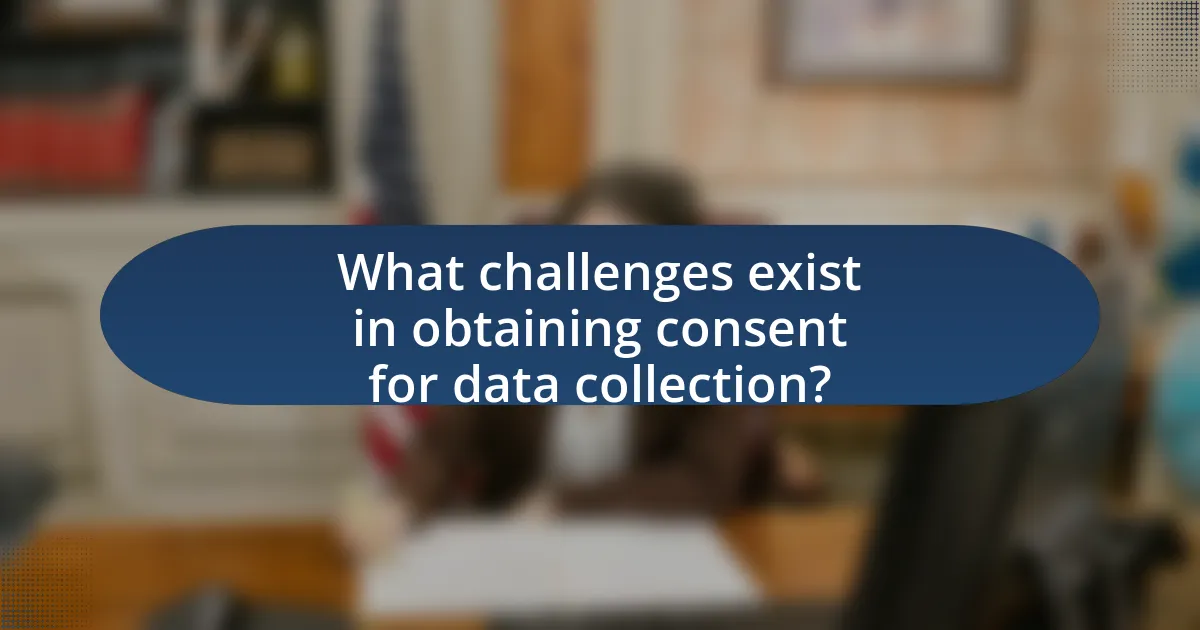
What challenges exist in obtaining consent for data collection?
Obtaining consent for data collection faces several challenges, primarily related to user understanding, trust, and regulatory compliance. Users often struggle to comprehend complex privacy policies and terms of service, leading to uninformed consent. A study by the Pew Research Center found that 79% of Americans are concerned about how their data is being used, indicating a lack of trust in organizations handling their information. Additionally, varying regulations, such as the General Data Protection Regulation (GDPR) in Europe, impose strict requirements for consent that can complicate the process for organizations. These factors collectively hinder effective consent acquisition, making it difficult for entities to ensure that consent is both informed and compliant with legal standards.
What are common barriers to obtaining user consent?
Common barriers to obtaining user consent include lack of understanding, complexity of consent forms, and distrust in data handling practices. Users often struggle to comprehend legal jargon and lengthy terms, leading to confusion about what they are consenting to. Research indicates that 70% of users do not read privacy policies thoroughly, which highlights the issue of complexity. Additionally, concerns about data misuse and privacy breaches contribute to distrust, as evidenced by a 2021 survey where 81% of respondents expressed concern about how their data is used. These factors collectively hinder the effective acquisition of informed user consent.
How does user awareness affect consent rates?
User awareness significantly increases consent rates. When individuals are informed about how their data will be used, the benefits of sharing their information, and their rights regarding data privacy, they are more likely to provide consent. Research indicates that clear communication and transparency about data practices can lead to higher trust levels, which directly correlates with increased willingness to consent. For example, a study published in the Journal of Privacy and Confidentiality found that users who received detailed explanations about data usage were 30% more likely to agree to data collection compared to those who were not informed. This demonstrates that enhancing user awareness is a critical factor in improving consent rates in data collection practices.
What role does technology play in consent challenges?
Technology significantly complicates consent challenges by enabling the collection, storage, and analysis of personal data at unprecedented scales. The rise of digital platforms and applications often leads to ambiguous consent mechanisms, where users may not fully understand what they are agreeing to due to complex terms of service and privacy policies. For instance, a study by the Pew Research Center found that 79% of Americans are concerned about how their data is being used by companies, highlighting a disconnect between user awareness and actual consent practices. This technological landscape creates an environment where informed consent is difficult to achieve, as users frequently encounter default settings that favor data sharing over privacy.
How can organizations address these challenges?
Organizations can address challenges related to consent in data collection practices by implementing transparent data policies and obtaining explicit consent from users. By clearly communicating how data will be used and ensuring that consent is informed, organizations can build trust with their users. Research indicates that 88% of consumers are more likely to engage with brands that prioritize transparency in data practices. Additionally, organizations should regularly review and update their consent mechanisms to comply with evolving regulations, such as the General Data Protection Regulation (GDPR), which mandates that consent must be freely given, specific, informed, and unambiguous. This proactive approach not only mitigates legal risks but also enhances customer loyalty and satisfaction.
What best practices can improve consent acquisition?
Best practices that can improve consent acquisition include providing clear and concise information about data usage, ensuring transparency in data collection processes, and utilizing user-friendly consent mechanisms. Clear communication helps individuals understand what they are consenting to, which increases trust and willingness to provide consent. Transparency about data usage fosters a sense of security, as users are more likely to consent when they know how their data will be handled. User-friendly consent mechanisms, such as simple opt-in forms and easy-to-understand language, enhance the likelihood of obtaining consent, as evidenced by studies showing that simplified consent processes lead to higher consent rates.
How can feedback mechanisms enhance consent processes?
Feedback mechanisms can enhance consent processes by providing individuals with ongoing opportunities to express their preferences and concerns regarding data use. These mechanisms facilitate real-time communication, allowing participants to adjust their consent based on evolving understanding or context. For instance, studies have shown that when individuals receive updates about how their data is being used, they are more likely to feel in control and satisfied with the consent process, leading to higher trust levels. Research published in the Journal of Medical Internet Research indicates that transparent feedback loops significantly improve user engagement and consent retention, demonstrating the effectiveness of feedback in fostering informed consent.

What are the consequences of neglecting consent in data collection?
Neglecting consent in data collection can lead to severe legal, ethical, and reputational consequences. Legally, organizations may face penalties under regulations such as the General Data Protection Regulation (GDPR), which imposes fines up to 4% of annual global turnover for non-compliance. Ethically, disregarding consent undermines trust between individuals and organizations, potentially resulting in public backlash and loss of customer loyalty. Additionally, data breaches or misuse of information can lead to lawsuits and further financial losses. These consequences highlight the critical importance of obtaining informed consent in data collection practices.
What risks do organizations face without proper consent?
Organizations face significant legal, financial, and reputational risks without proper consent. Legally, they may violate data protection regulations such as the General Data Protection Regulation (GDPR), which can result in fines up to 4% of annual global revenue or €20 million, whichever is higher. Financially, the lack of consent can lead to costly lawsuits and settlements from affected individuals. Reputationally, organizations risk losing customer trust and loyalty, which can have long-term impacts on their market position and profitability. For instance, a study by the Ponemon Institute found that 63% of consumers would stop purchasing from a company that mishandles their data.
How can neglecting consent lead to legal repercussions?
Neglecting consent can lead to legal repercussions such as fines, lawsuits, and regulatory penalties. In many jurisdictions, laws like the General Data Protection Regulation (GDPR) in the European Union mandate that individuals must provide explicit consent for their personal data to be collected and processed. Failure to obtain this consent can result in significant financial penalties, with fines reaching up to 4% of a company’s annual global turnover or €20 million, whichever is higher. Additionally, individuals may pursue legal action against organizations that misuse their data, leading to costly litigation and reputational damage.
What impact does it have on brand reputation?
The impact of consent in data collection practices on brand reputation is significant; brands that prioritize consent tend to build stronger trust with consumers. When companies transparently obtain consent, they demonstrate respect for customer privacy, which enhances their credibility and fosters loyalty. According to a 2021 survey by the International Association of Privacy Professionals, 79% of consumers are more likely to trust brands that are transparent about their data practices. Conversely, brands that neglect consent can face backlash, leading to negative publicity and diminished consumer trust, as evidenced by incidents like the Cambridge Analytica scandal, which severely damaged Facebook’s reputation.
What are the long-term effects of poor consent practices?
The long-term effects of poor consent practices include erosion of trust, legal repercussions, and potential harm to individuals. Erosion of trust occurs when individuals feel their autonomy is compromised, leading to reluctance in future participation in data collection. Legal repercussions can arise from violations of regulations such as the General Data Protection Regulation (GDPR), which mandates informed consent; non-compliance can result in significant fines and reputational damage. Additionally, individuals may experience psychological harm or data misuse, which can have lasting impacts on their privacy and security. These effects highlight the critical need for robust consent practices in data collection.
How does it affect customer loyalty and retention?
Consent in data collection practices significantly enhances customer loyalty and retention. When customers feel their data is collected transparently and ethically, they are more likely to trust the brand, leading to increased loyalty. A study by the Data & Marketing Association found that 79% of consumers are more likely to engage with brands that respect their privacy and obtain consent. This trust fosters long-term relationships, as customers are inclined to return to brands that prioritize their preferences and data security.
What implications does it have for future data collection efforts?
The implications for future data collection efforts center on the necessity of obtaining informed consent from participants. This requirement ensures ethical standards are upheld, fostering trust between data collectors and participants. Research indicates that 79% of consumers express concern over how their data is used, highlighting the need for transparency in data practices. Furthermore, regulations such as the General Data Protection Regulation (GDPR) mandate explicit consent, influencing how organizations design their data collection strategies. Consequently, future data collection efforts must prioritize clear communication about data usage and participant rights to comply with legal standards and enhance participant engagement.
What are best practices for obtaining and managing consent in data collection?
Best practices for obtaining and managing consent in data collection include providing clear, concise information about the data being collected, its purpose, and how it will be used. Organizations should ensure that consent is obtained through an affirmative action, such as checking a box or signing a form, rather than through passive acceptance. Transparency is crucial; individuals should be informed of their rights regarding their data, including the ability to withdraw consent at any time. Additionally, organizations must implement robust data management systems to securely store consent records and regularly review consent practices to ensure compliance with relevant regulations, such as the General Data Protection Regulation (GDPR), which mandates explicit consent for data processing.
How can organizations create user-friendly consent forms?
Organizations can create user-friendly consent forms by using clear language, simplifying the design, and ensuring transparency about data usage. Clear language avoids legal jargon, making it easier for users to understand what they are consenting to. Simplified design, including bullet points and headings, enhances readability and allows users to quickly find relevant information. Transparency about data usage, including specific details on how data will be collected, stored, and shared, builds trust and encourages informed consent. Research indicates that user-friendly consent forms can significantly increase user engagement and compliance, as evidenced by a study published in the Journal of Medical Internet Research, which found that simplified consent processes improved participant understanding and willingness to participate in studies.
What ongoing practices should be implemented to maintain consent integrity?
Ongoing practices to maintain consent integrity include regular audits of consent processes, transparent communication with data subjects, and continuous training for staff on ethical data handling. Regular audits ensure that consent mechanisms are functioning correctly and comply with legal standards, while transparent communication fosters trust and allows individuals to understand how their data will be used. Continuous training for staff reinforces the importance of consent and ethical practices, which is crucial given that 79% of consumers express concerns about how their data is used, according to a 2021 survey by Pew Research Center. These practices collectively help organizations uphold consent integrity in data collection.
